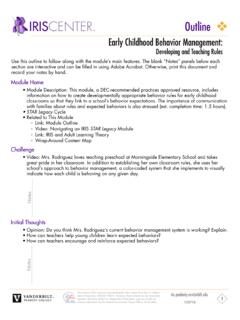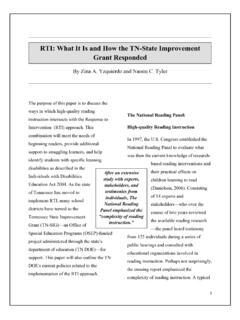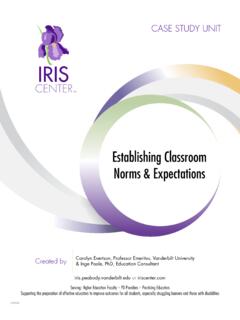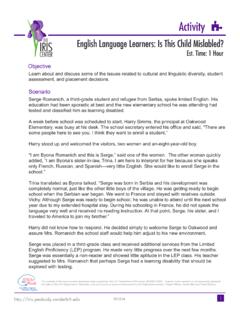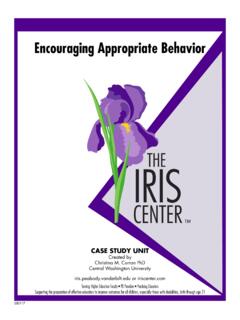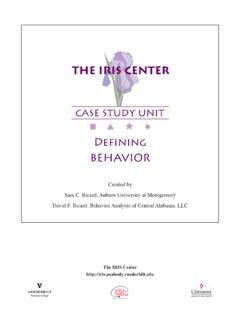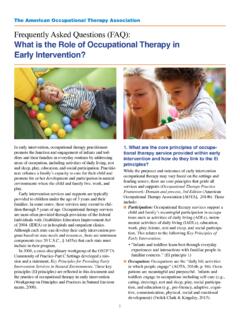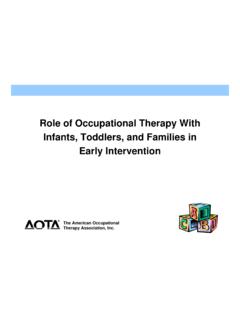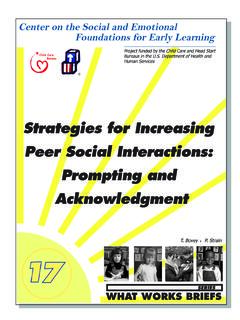Transcription of Early Childhood Behavior Management - Vanderbilt University
1 Or : Higher Education Faculty PD Providers Practicing EducatorsSupporting the preparation of effective educators to improve outcomes for all children, especially those with disabilities, birth through age 21 THEIRISCENTER with Instructor s GuideEarly ChildhoodBehavior ManagementCASE STUDY UNITC reated byJessica Hardy, Janice BrownKim Skow120915 IRIS@VU Modules and Materials DevelopmentNaomi C. Tyler, Ph D Co-DirectorVanderbilt UniversityPhone: (615) 343-5610 or (800) 831-6134 Fax: (615) 343-5611 Email: @CGU Technical Assistance and TrainingDeborah D. Smith, Ed D Co-DirectorClaremont Graduate UniversityPhone: (909) 607-8982 or (866) 626-IRIS [4747]Fax: (909) 607-0959 Email: contents of this resource were developed under a grant from the Department of Education, #H325E120002.
2 However, those contents do not necessarily represent the policy of the Department of Education, and you should not assume endorsement by the Federal Government. Project Officers, Sarah Allen and Tracie Childhood Behavior ManagementContents: PageIntroduction ..1 Case Study Level A, Case 1 ..3 Case Study Level A, Case 2 ..4 Case Study Level B, Case 1 ..5 Case Study Level B, Case 2 ..6 Case Study Level B, Case 3 ..7 Case Study Level C, Case 1 ..8 STAR Sheet: Behavior Expectations and Rules ..10 STAR Sheet: Developing Rules ..13 STAR Sheet: Intentionally and Systematically Teaching Rules ..17 STAR Sheet: Encouraging Appropriate Behavior .
3 20 STAR Sheet: Considerations for Special Populations ..25 STAR Sheet: Supporting Children with Significant Challenging Behavior .29 STAR Sheet: Partnering with or Engaging Families ..33 Instructor s Guide ..36To cite this Case Study Unit:Hardy J ., Brown J ., Skow K ., & the IRIS Center . (2015) . Early Childhood Behavior Management . Retrieved on [month day, year,] from http://iris .peabody . Vanderbilt .edu/case_studies/ECBM . of ContentsTable of ContentsFor an Instructor s Guide to this case study, please email your full name, title, and institutional affiliation to the IRIS Center at iris@ Vanderbilt .edu . Early Childhood Behavior ManagementIntroductionEarly Childhood teachers identify challenging behaviors as one of the most difficult aspects of their jobs and one for which they feel the least prepared.
4 This is reflected by the fact that program directors or elementary school administrators report that many Early Childhood teachers lack the skills necessary to address challenging behaviors . Teachers can prevent many challenging behaviors from occurring by developing effective classroom rules . This includes systematically teaching the rules and encouraging children to follow them, a practice that can have a significant effect on children s Behavior and create a more positive classroom environment . Often, preventing challenging behaviors from occurring in the first place is a more effective practice than addressing them after they occur.
5 Doing so might also prevent negative outcomes, such as academic failure and peer rejection, for those students who engage in challenging behaviors .This Case Study addresses a number of the Division for Early Childhood s (DEC) Recommended Practices (see below) . The Recommended Practices provide guidance to Early Childhood professionals working with young children birth through age five who have or are at-risk for developmental delays or disabilities . They also provide guidance to the families of these children related to the most effective ways to improve children s learning outcomes and development .EnvironmentE1. Practitioners provide services and supports in natural and inclusive environments during daily routines and activities to promote the child s access to and participation in learning experiences.
6 FamilyF1. Practitioners build trusting and respectful partnerships with the family through interactions that are sensitive and responsive to cultural, linguistic, and socio- economic diversity .F2. Practitioners provide the family with up-to-date, comprehensive and unbiased information in a way that the family can understand and use to make informed choices and decisions .InstructionINS4. Practitioners plan for and provide the level of support, accommodations, and adaptations needed for the child to access, participate, and learn within and across activities and routines .INS5 . Practitioners embed instruction within and across routines, activities, and environments to provide contextually relevant learning opportunities.
7 INS6. Practitioners use systematic instructional strategies with fidelity to teach skills and to promote child engagement and learning .INS9. Practitioners use functional assessment and related prevention, promotion, and intervention strategies across environments to prevent and address challenging Behavior . LeadershipL13. Leaders promote efficient and coordinated service delivery for children and families by creating the conditions for practitioners from multiple disciplines and the family to work together as a team . n1http://iris .peabody . Vanderbilt .eduTHEIRISCENTERlIntroductionResourcesD ivision for Early Childhood . (2014) . DEC recommended practices in Early intervention/ Early Childhood special education 2014.
8 Retrieved from http://www .dec-sped .org/recommendedpracticesFox, L ., & Smith, B . J . (2007) . Promoting social, emotional and behavioral outcomes of young children served under IDEA. Issue Brief . Technical Assistance Center on Social Emotional Intervention for Young Children . n2http://iris .peabody . Vanderbilt .edusEarly Childhood Behavior ManagementLevel A Case 1 ScenarioMs . Allegra is preparing for her second year of teaching kindergarten . She has transferred from a suburban school with little student diversity to an urban school with many students from a variety of cultural, linguistic, and ethnic backgrounds . Ms . Allegra s new school has three school-wide Behavior expectations: be respectful, be responsible, be safe.
9 She needs to develop classroom rules that align with these Behavior expectations, keeping in mind the age of the students and the diversity of her classroom . Ms . Allegra welcomes the opportunity to work on her classroom rules because the ones she had last year were not very effective .Possible Strategies Behavior Expectations and Rules Developing Rules! Assignment1 . Review the Case Study Set Introduction and STAR Sheets for each possible strategy listed above . 2 . Briefly describe two factors Ms . Allegra needs to consider when developing her classroom rules .3 . List the four criteria for developing classroom rules .4 . Help Ms.
10 Allegra to develop a new set of classroom rules that align with her school s Behavior expectations . 3 StudysEarly Childhood Behavior ManagementLevel A Case 2 ScenarioFor the past five years, Ms . Kiersten has taught second grade . This is her first year teaching in an inclusive three-year-old classroom . As in the past, she has developed classroom rules and posted them on the wall . Although she does not have a lot of experience working with younger children, she is aware that, because they are young, she needs to review the rules each morning . She also gives the children periodic reminders throughout the day when she sees one of them not following a rule.
